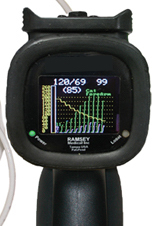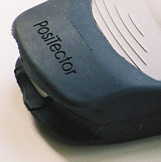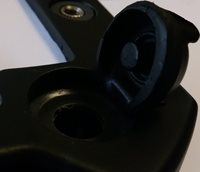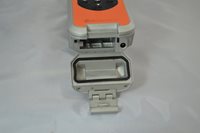Custom Rubber Protective Case | Custom Silicone Protective Case
Designing a protective case follows four steps:
- Knowing the geometry of the enclosure
- Understanding the type of protection required
- Understanding the areas requiring protection & the importance of easy install | removal
- Understanding the environment for material selection
- Rapid prototyping
1. Knowing the geometry of the enclosure
The first step in designing a protective rubber or silicone cover for an industrial instrument is to secure a solid model or 3D computer drawing of the enclosure. This geometry will ultimately become the inside geometry of the rubber cover and any incorrect geometry at this first stage can result in a rubber or silicone protective case that doesn't fit tightly.
In instances where the enclosure is custom-designed internally, securing the necessary computer model is generally not a problem.
In cases where the enclosure is a stock item supplied by someone else, or an entire device sold by someone else, it may not be possible to get the original 3D model of the plastic. Custom Rubber Corp. can assist with developing the required computer model. There have been significant advances in reverse engineering tools that scan a solid object and generate a computer 3D model. Custom Rubber Corp. works with a number of companies that have these capabiltities and can coordinate this step, or we can recommend a few companies who can do what's required.
Ultimately, once a 3D computer model in a file format that SolidWorks can interpret is complete, the design of the custom silicone protective case or custom rubber protective case can move to the next phase.
2. Understanding the type of protection required
Molded rubber or molded silicone cases can provide a number of different functions - it's important to determine which type of protection is critical and which, if any, should also be considered. Below are three typical types of protection:
- Is the protective molded silicone case needed for weatherproofing? If so, it's important that the case cover any parting lines in the enclosure and insure a tight fit.
- Is the protective molded rubber case needed for impact / drop-proofing? If so, attention needs to be focused on the edges and corners, and around any screens or other vulnerable probes or external sensors. The example here shows the molded rubber protecting around the screen & protecting the connection point at the top:

- Is the protective molded silicone case needed to improve the user interaction or aesthetics? If so, care needs to be taken to insure the case enhances the user's ability to hold the case without dropping it and maybe accentuating the key attributes of the plastic enclosure. In many instances, Custom Rubber Corp. can engrave company logos, contact information, etc. directly into the protective case.

3. Understanding the areas requiring protection & the importance of easy install | removal
Generally it's obvious which areas of the device need to be visible or available to the user. If there is a screen or buttons or a small keyboard - any of these things have to be left exposed to ensure the function of the device is not inhibited by the protective enclosure. The challenge is designing the case to expose certain areas while still protecting the device and staying in place.
Another consideration is how often and how easy the case should be installed and removed; sometimes protective cases are designed to be installed at the factory and never removed, other times the case has to be easily removable to change batteries or connect to external devices.
- Often there are charging ports or connections on the device that need to be accessible. The custom rubber protective case can incorporate plugs that protect those connections when not in use but can be pulled out of the way when a connection is required.

- Sometimes there is a battery compartment that has to be accessed. Should users be required to remove the protective case to access the batteries or should the case leave the battery compartment exposed?

- Does the device have any mating devices - a charging station or dash-board holder - that should work with the protective case installed?
4. Understanding the environment for material selection
Generally, Custom Rubber Corp. recommends Silicone Rubber for protective cases used on electronic devices. The silicone does not bloom or turn white over time, has a nice tactile feel, and is generally resistant to most work environments. There are instances when the protective cover may require a different material.
Rubber Materials for Custom Rubber Protective Cases
| Material |
Abbreviation |
Relative Price |
Color Fast * |
Ozone, UV Resistance |
Oil Resistance |
Elasticicity |
| Silicone |
VQM |
Fair |
Excellent |
Excellent |
Fair |
Good |
| Ethylene-Propylene |
EPDM |
Excellent |
Fair |
Excellent |
Poor |
Good |
| Neopren / Chloroprene |
CR |
Excellent |
Good |
Good |
Fair |
Good |
| Natural |
NR |
Good |
Fair |
Fair |
Poor |
Excellent |
* Some rubber materials tend to "Bloom" over time. Bloom is generally a white waxy substance that works its way to the surface over time. It can be wiped off but generally it does come back. For cosmetic parts, bloom is generally not desireable. The scale for the chart is; Excellent = no bloom, Poor = always bloom.
5. Rapid prototyping
Custom Rubber Corp. can assist with developing a rapid prototype - this is a step that is generally recommended.
Below is pictured a silicone "soft tool" that was made from a hard plastic SLA model of the proposed protective case. Shown in front is one of the cast urethane prototype parts that the tool made.

It's important to note a few things about the case urethane prototypes:
- They are a cost effective and relatively quick way to get samples of the protective case
- The urethane can replicate the hardness of the proposed material pretty closely
However:
- The urethane is not as flexible as the actual material and may not stretch as much for installation and removal
- The urethane has a more slippery feel compared to the recommended silicone that Custom Rubber Corp. often uses - therefore the actual protective case will be a bit better in enhancing the grip the user has on the device